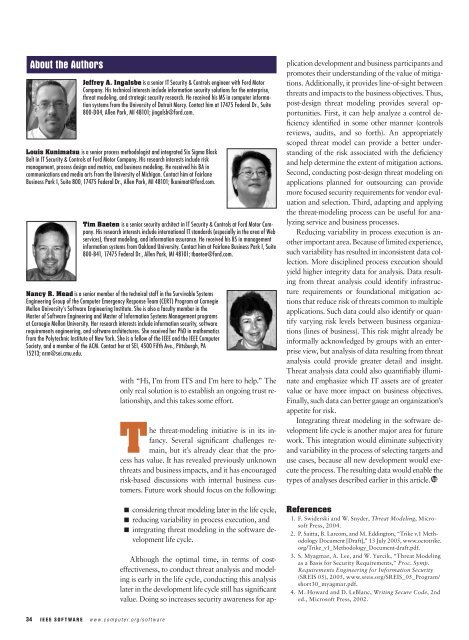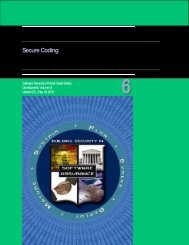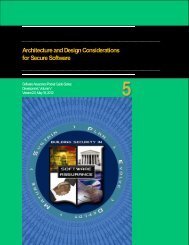Threat Modeling: Diving into the Deep End - Build Security In
Threat Modeling: Diving into the Deep End - Build Security In
Threat Modeling: Diving into the Deep End - Build Security In
Create successful ePaper yourself
Turn your PDF publications into a flip-book with our unique Google optimized e-Paper software.
About <strong>the</strong> AuthorsJeffrey A. <strong>In</strong>galsbe is a senior IT <strong>Security</strong> & Controls engineer with Ford MotorCompany. His technical interests include information security solutions for <strong>the</strong> enterprise,threat modeling, and strategic security research. He received his MS in computer informationsystems from <strong>the</strong> University of Detroit Mercy. Contact him at 17475 Federal Dr., Suite800-D04, Allen Park, MI 48101; jingalsb@ford.com.Louis Kunimatsu is a senior process methodologist and integrated Six Sigma BlackBelt in IT <strong>Security</strong> & Controls at Ford Motor Company. His research interests include riskmanagement, process design and metrics, and business modeling. He received his BA incommunications and media arts from <strong>the</strong> University of Michigan. Contact him at FairlaneBusiness Park I, Suite 800, 17475 Federal Dr., Allen Park, MI 48101; lkunimat@ford.com.Tim Baeten is a senior security architect in IT <strong>Security</strong> & Controls at Ford Motor Company.His research interests include international IT standards (especially in <strong>the</strong> area of Webservices), threat modeling, and information assurance. He received his BS in managementinformation systems from Oakland University. Contact him at Fairlane Business Park I, Suite800-B41, 17475 Federal Dr., Allen Park, MI 48101; tbaeten@ford.com.Nancy R. Mead is a senior member of <strong>the</strong> technical staff in <strong>the</strong> Survivable SystemsEngineering Group of <strong>the</strong> Computer Emergency Response Team (CERT) Program at CarnegieMellon University’s Software Engineering <strong>In</strong>stitute. She is also a faculty member in <strong>the</strong>Master of Software Engineering and Master of <strong>In</strong>formation Systems Management programsat Carnegie Mellon University. Her research interests include information security, softwarerequirements engineering, and software architectures. She received her PhD in ma<strong>the</strong>maticsfrom <strong>the</strong> Polytechnic <strong>In</strong>stitute of New York. She is a fellow of <strong>the</strong> IEEE and <strong>the</strong> IEEE ComputerSociety, and a member of <strong>the</strong> ACM. Contact her at SEI, 4500 Fifth Ave., Pittsburgh, PA15213; nrm@sei.cmu.edu.with “Hi, I’m from ITS and I’m here to help.” Theonly real solution is to establish an ongoing trust relationship,and this takes some effort.The threat-modeling initiative is in its infancy.Several significant challenges remain,but it’s already clear that <strong>the</strong> processhas value. It has revealed previously unknownthreats and business impacts, and it has encouragedrisk-based discussions with internal business customers.Future work should focus on <strong>the</strong> following:■■■considering threat modeling later in <strong>the</strong> life cycle,reducing variability in process execution, andintegrating threat modeling in <strong>the</strong> software developmentlife cycle.Although <strong>the</strong> optimal time, in terms of costeffectiveness,to conduct threat analysis and modelingis early in <strong>the</strong> life cycle, conducting this analysislater in <strong>the</strong> development life cycle still has significantvalue. Doing so increases security awareness for ap-plication development and business participants andpromotes <strong>the</strong>ir understanding of <strong>the</strong> value of mitigations.Additionally, it provides line-of-sight betweenthreats and impacts to <strong>the</strong> business objectives. Thus,post-design threat modeling provides several opportunities.First, it can help analyze a control deficiencyidentified in some o<strong>the</strong>r manner (controlsreviews, audits, and so forth). An appropriatelyscoped threat model can provide a better understandingof <strong>the</strong> risk associated with <strong>the</strong> deficiencyand help determine <strong>the</strong> extent of mitigation actions.Second, conducting post-design threat modeling onapplications planned for outsourcing can providemore focused security requirements for vendor evaluationand selection. Third, adapting and applying<strong>the</strong> threat-modeling process can be useful for analyzingservice and business processes.Reducing variability in process execution is ano<strong>the</strong>rimportant area. Because of limited experience,such variability has resulted in inconsistent data collection.More disciplined process execution shouldyield higher integrity data for analysis. Data resultingfrom threat analysis could identify infrastructurerequirements or foundational mitigation actionsthat reduce risk of threats common to multipleapplications. Such data could also identify or quantifyvarying risk levels between business organizations(lines of business). This risk might already beinformally acknowledged by groups with an enterpriseview, but analysis of data resulting from threatanalysis could provide greater detail and insight.<strong>Threat</strong> analysis data could also quantifiably illuminateand emphasize which IT assets are of greatervalue or have more impact on business objectives.Finally, such data can better gauge an organization’sappetite for risk.<strong>In</strong>tegrating threat modeling in <strong>the</strong> software developmentlife cycle is ano<strong>the</strong>r major area for futurework. This integration would eliminate subjectivityand variability in <strong>the</strong> process of selecting targets anduse cases, because all new development would execute<strong>the</strong> process. The resulting data would enable <strong>the</strong>types of analyses described earlier in this article.References1. F. Swiderski and W. Snyder, <strong>Threat</strong> <strong>Modeling</strong>, MicrosoftPress, 2004.2. P. Saitta, B. Larcom, and M. Eddington, “Trike v.1 MethodologyDocument [Draft],” 13 July 2005, www.octotrike.org/Trike_v1_Methodology_Document-draft.pdf.3. S. Myagmar, A. Lee, and W. Yurcik, “<strong>Threat</strong> <strong>Modeling</strong>as a Basis for <strong>Security</strong> Requirements,” Proc. Symp.Requirements Engineering for <strong>In</strong>formation <strong>Security</strong>(SREIS 05), 2005, www.sreis.org/SREIS_05_Program/short30_myagmar.pdf.4. M. Howard and D. LeBlanc, Writing Secure Code, 2nded., Microsoft Press, 2002.34 I E E E S o f t w a r e w w w . c o m p u t e r. o r g / s o f t w a r e
















